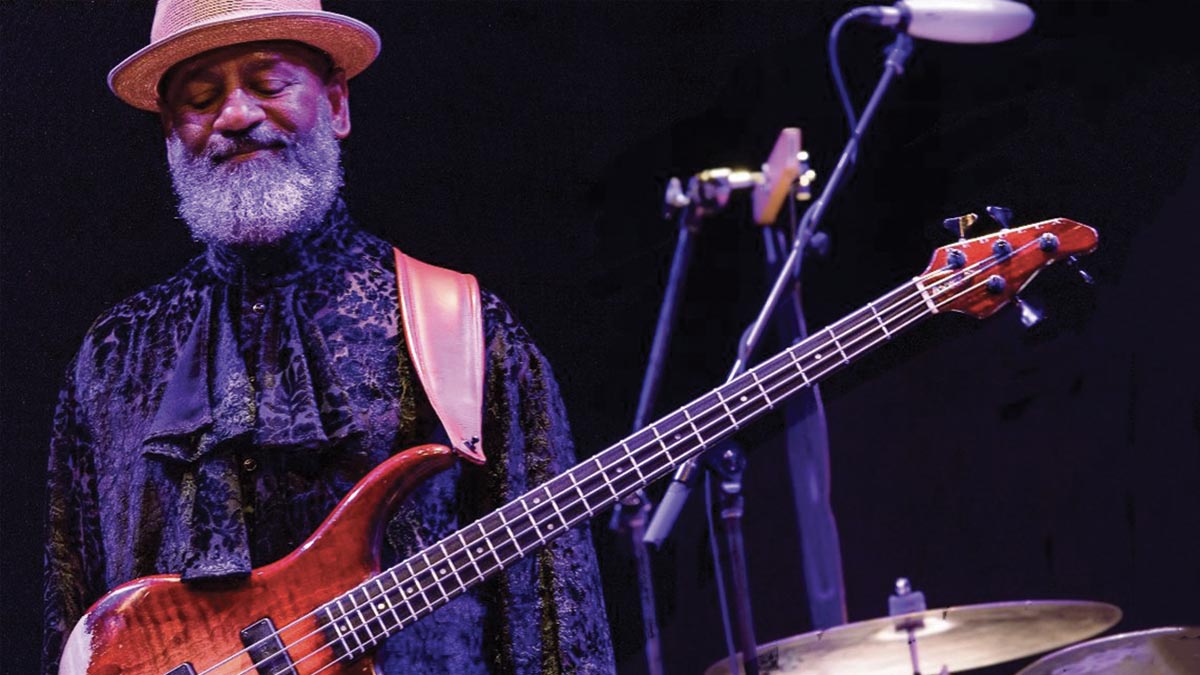Burnt Sugar’s Jared Michael Nickerson: “I’ve never been a two-fingers bass player... Most of my recording career is based on plucking with my thumb”
The Burnt Sugar Arkestra the Chamber bassist continues the grand funk tradition of his fellow Ohio players, without fingers or pick

Burnt Sugar – whose full title is Burnt Sugar, The Arkestra Chamber – makes music like you’ve never heard before. In fact, they’ve never really heard it, either: this highly improvisatory and eclectic group creates new pieces every performance via a special hand-signal conducting system.
The collective is co-led by groove-guru bassist Jared Michael Nickerson, whose musical background spans funk, rock, pop, and more. His upbringing in Dayton, Ohio informs that span of genres, and in turn his stylistic choices in Burnt Sugar.
Nickerson and the band recently released a new album, Angels Over Oakanda, so we hit him with some burning questions.
How does Angels Over Oakanda differ from Burnt Sugar’s other albums?
“It could probably be linked right up to the first four records as far as its spirit, but it’s pandemic-related. When the bottom fell out of the industry last year, we started to go back into our unreleased catalog. Our founder, Greg Tate, found a session from 2018 that had a 23-minute jam that was based off a loop.
“We shared the original track around to different members to fill out and reimagine the parts. Ultimately, it’s a digital collaboration from around the world of five or six really incredible musical artists of the Burnt Sugar family that brings us back to our conducted roots. Rather than being physically conducted, they were digitally conducted through the recording process from that 23-minute session.”
Over the last 10 years, I’ve gone to more of a banjo style where I use the thumb and two fingers and get into a picking style like a banjo roll
There’s a flurry of notes in your bassline for Oakanda Overdrive that seems like a new technique compared for you.
Get The Pick Newsletter
All the latest guitar news, interviews, lessons, reviews, deals and more, direct to your inbox!
“Well, I’ve never been a two-fingers bass player: I’ve always plucked with my thumb. My first bass was a Harmony that had a tug bar under the G string, which just reinforced that style. Most of my recording career is based on plucking with my thumb: Freedy Johnston’s Can You Fly [1992], Charlie Musselwhite’s Sanctuary [2004], Gary Lucas’s Gods And Monsters [1992].
“You know, there are limitations to it. There’s a lot of speed things I can’t do, but I never really worried about that because I realized that it would give me something that was mine. Over the last 10 years, though, I’ve expanded on that, and have gone to more of a banjo style where I use the thumb and two fingers and get into a picking style like a banjo roll.”
What gear are you running these days?
“I used to love heavy gear, but now everything is DIY and the days of lugging that gear aren’t around for me any longer. For amps, I use an Eich T900, which weighs like eight pounds. That goes into my Schroeder bass cabinets, which weigh 23 pounds.
“Years ago, I was introduced to Michael Pedulla and I bought one of his Thunderbasses, which was the 124th bass he ever made. That’s basically that’s what I play to this day. Effects-wise, I use an Electro-Harmonix White Finger Flanger and a Boss Dynamic Filter. For strings, I’m a flatwound person and I use La Bella Deep Talking Flats.”
Music has taken you around the world, but it all started in the musical hotbed of Ohio in the ’70s. Can you paint that picture for us?
“What people don’t realize about Ohio is that the northern part, like Cleveland, is industrial and hard scrabble. You go to southern Ohio, though, and Southern sensibilities are really engrained in people. I was born in Cleveland, and moved to Dayton as a child. Dayton had most of the linchpins that Southern communities had, including a strong church system, so there were a lot of kids that would play in church.
“Dayton produced the Ohio Players, Zapp & Roger, and the McCoys, who did Hang On Sloopy in 1965. The city has a rock history, too, which I became more involved in when I came back from Boston in the ’80s and joined the Cleveland band Human Switchboard.
“So there was always good local music, and dance was always important in my family. The radio was a vital component to my musical upbringing, as well. I remember when I was in the seventh grade, I was in our rec room and the station played Sugar Pie, Honey Bunch by the Four Tops, followed by Somebody to Love by Jefferson Airplane, and I danced through both of them. It didn’t hit me until later that they both have driving bass and drums.”
- Angels Over Oakanda is out now.
“I asked him to get me four bass strings because I only had a $29 guitar from Sears”: Bootsy Collins is one of the all-time bass greats, but he started out on guitar. Here’s the sole reason why he switched
“I got that bass for $50 off this coke dealer. I don’t know what Jaco did to it, but he totally messed up the insides!” How Cro-Mags’ Harley Flanagan went from buying a Jaco Pastorius bass on the street to fronting one of hardcore’s most influential bands










